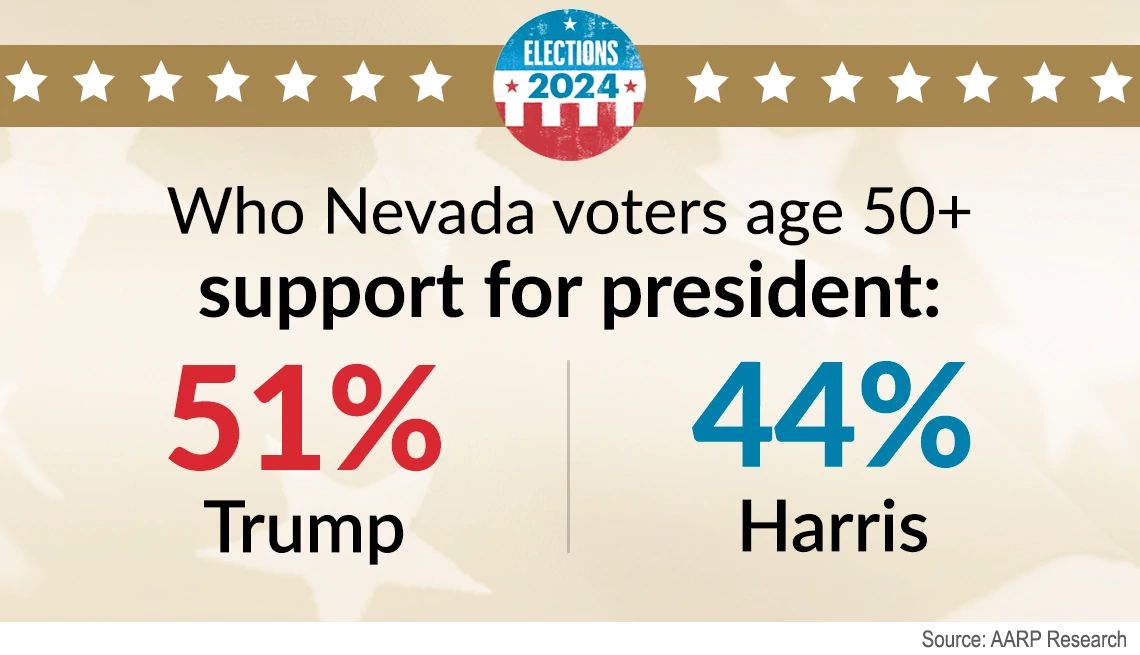AARP Hearing Center


In the close race for U.S. president, Republican Donald Trump holds a razor-thin lead over Democrat Kamala Harris in the battleground state of Nevada, according to an exclusive AARP poll released Tuesday.
Former president Trump has support from 47 percent of likely voters in the Silver State, compared to 46 percent for Vice President Kamala Harris. Voters 50 and older are fueling Trump’s small advantage, with 51 percent backing Trump and 44 percent lining up behind Harris.
Harris became the Democratic presidential nominee Aug. 5 after President Joe Biden announced he was exiting the race. Her entry has helped Democrats: Harris has seen a 9-percentage-point gain in support among all Nevada voters and a 6-percentage-point gain among voters 50-plus compared to Biden’s position in June, when AARP last surveyed Nevada voters. Trump has seen a 3-percentage-point increase among all voters and a 1-percentage-point gain among voters 50-plus during the same time period.
Pollsters interviewed 1,368 likely Nevada voters between Oct. 8 and Oct. 15. The bipartisan team of Democratic-leaning Impact Research and Republican firm Fabrizio Ward conducted the AARP-commissioned poll, which has a margin of error of plus or minus 4 percent for all likely voters and plus or minus 3.5 percent for voters 50-plus.


Harris has also improved her standing among Hispanic voters over Biden. Fifty-five percent of Latino voters 50-plus say they back Harris, an 8-percentage point increase from Biden’s level of support in June. Trump has backing from 40 percent of older Latino voters, an increase of two percentage points from June’s polling results.
Hispanic voters are a critical voting group in Nevada, making up a fifth of the overall electorate, and they could make the difference in the election, says Jeff Liszt, a partner with Impact Research. Hispanic voters tend to lean Democratic, he says, but candidates can reach them by addressing pocketbook issues.
“Hispanic voters are really focused on inflation and costs. There’s more concern about inflation among Hispanic voters 50-plus than white voters,” Liszt says.
With the presidential race expected to be close nationally and in the seven battleground states, the smallest margins could decide the presidency. Democratic president Joe Biden won Nevada’s six Electoral College votes in 2020 by 2.4 percentage points. This year’s election in Nevada is promising to be equally tight. While Nevada has the fewest electoral votes of any of the seven battleground states, “there is actually still a chance that Nevada will be the deciding state,” Liszt says. “Harris’ path to victory gets more complicated if she loses Nevada.”







































































More From AARP
Voting Can Be a Struggle for Nursing Home Residents
Casting a ballot can be difficult — and controversial — depending on the stateAARP Exclusive: Harris and Trump Reveal Where They Stand
Presidential candidates on Social Security, Medicare, prescription prices and moreHow to Register and Vote in the 2024 Election
State-by-state guide to everything you need to knowRecommended for You